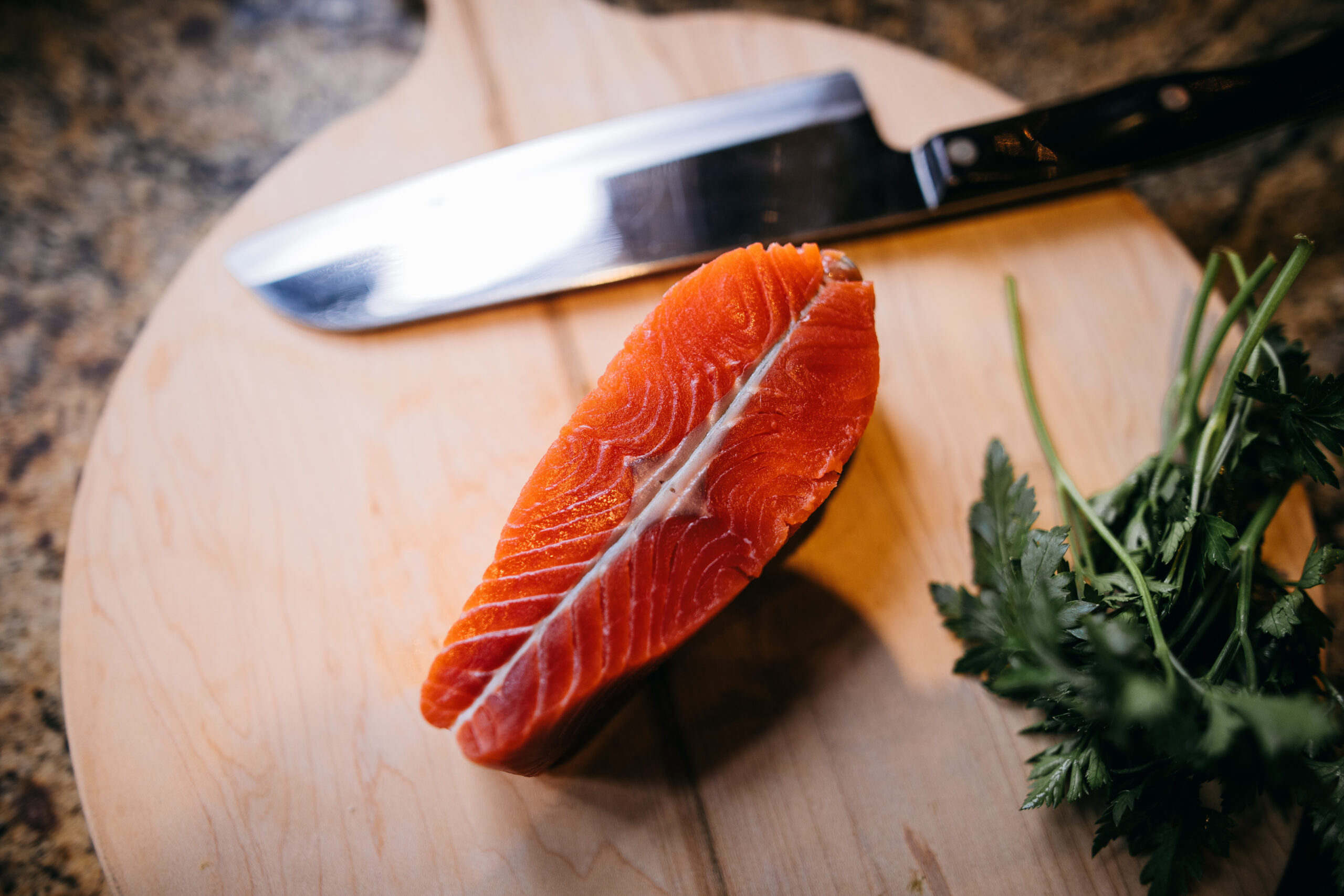Fresh fish: something we could all use a little more of.
While we are eating more and more fish as a whole, we still aren’t eating enough. Did you know the American Heart Association recommends at least two 8-oz servings of fish a week?
If you’re not hitting your fist-eating quota, don’t feel bad, 80-90% of us aren’t either.
Don’t know where to start? How about some salmon. There are many great benefits of having fresh Alaskan salmon for dinner.
But be careful where you get your fish — not all fish are created equal. Here’s our ultimate guide as to why you should choose wild caught salmon over farm-raised salmon.
Why Salmon?
Let’s start with the basics. Why should salmon be an important part of our diet? I’m sure you’ve heard of omega-3s and omega-6s. These are the only two fatty acids that our body doesn’t produce on its own but are essential for our health.
That means we need to obtain these necessary fatty acids through our diet. Most of us get enough omega-6 through vegetable oil and corn. Omega-3, on the other hand, is harder to get. You need to eat things like flaxseed, grass-fed beef, and salmon.
Omega-3s help prevent chronic illnesses like arthritis and heart disease. So, unless you are having a flaxseed shake for breakfast, chances are you aren’t getting the omega-3s you need.
Wild Caught Salmon vs. Farm-Raised Salmon
When it comes to buying salmon, you have two choices: wild caught or farm-raised.
Wild caught salmon are harvested in the wild while living in their natural habitat. Farm-raised salmon are fish that are raised in controlled farms. The environment of these fish farms are vastly different than the natural habitat that is found in the wild.
Because of those different environments, farm-raised and wild caught salmon have some significant differences that every consumer should be aware of.
Omega-3 Levels
One of the most critical differences is that of the omega-3 levels. Salmon get their omega-3 content from their diet. They eat feeder fish like krill. Krill eat green algae. Green algae is an incredible natural source for omega-3 fatty acids.
The omega-3 nutrients then travel up the food chain until you consume it.
This food-chain pattern happens naturally in the wild, but in farms, the diet is left up to the farmer where there are typically some missing nutrients in the diet they feed the fish.
Even when fed high amounts of omega-3 oil, farm-raised salmon tend to have lower amounts of omega-3 fats.
In this case, the diet that nature provides is much better for all.
Living Conditions
The living conditions of wild caught salmon couldn’t be more different than that of farm-raised salmon.
Wild caught salmon are born in freshwater rivers and lakes and then grow in the ocean. In the wild, these fish have plenty of room to swim and roam. They also have a diverse and natural diet giving them a great resource for essential minerals and vitamins.
Farm-raised salmon, on the other hand, are raised in tight quarters where they are literally on top of each other. They don’t have to work for their food or swim as far.
Also, because of the close quarters, there is always the risk of disease spreading through the farm. Because of that, they are fed potent antibiotics and pesticides. This alone should be reason enough to avoid farm-raised seafood. These extra chemicals and substances end up in the food you eat.
Cooking with Wild Caught Salmon
Along with the nutritional differences between wild caught salmon and farm-raised salmon, there are differences when it comes to cooking and eating the fish.
Color
Wild caught salmon have a bright orange/red color to them. This is from the krill they eat. Farm-raised salmon are naturally a greyish color, and then a color-dye is added to their food which in turn makes their flesh look pink.
Cooking
Wild salmon actually requires less time to cook and can easily become dry if cooked too long. But following tried and true recipes can help with this.
Taste
Wild caught salmon tend to have a more robust taste, and once you realize that this is the way salmon should taste, you will be all the happier.
Fat Content
Because wild salmon swim farther distances, they tend to have leaner and less fatty bodies than their farm-raised cousins.
Farm raised fish don’t have to swim at all and have a sedentary life. Because of the lack of mobility, they have a higher fat content with more white fatty lines in the meat itself.
Sustainability
Being environmentally aware is important when dealing with markets that depend on nature for their products.
There are major concerns when it comes to how sustainable fish farms are. There is the risk of depleting the population of the small “feeder” fish that salmon consume. They are used in high amounts to feed the high number of salmon in the farms.
There is also the threat of the chemicals and pesticides used in fish farms leaking into the lakes and oceans.
Wild caught salmon do run the risk of being overfished which is why it’s vital only to support fishing companies who are monitored by ecologist and salmon experts.
It’s also important to note that the fishing industry sustains many towns and communities. These responsible companies support the local economy and uphold the local traditions of harvesting salmon on an annual basis.
Get Some Wild Caught Salmon
Next time you are planning to cook some fish, reach for wild caught salmon. Don’t just run to the nearest grocery store and buy the first fillet you see. As you now know, not all fish are created equal.
That’s where we come in. We are here to provide the freshest, healthiest, most sustainable fish in the industry. All of our salmon come straight from Alaska where the industry standards are high, and companies care about producing the best product possible.
So come check us out. You’ll love what we have to offer. And remember, we all need at least two seafood meals a week. So let’s start now so you can live your healthiest, yummiest, most satisfying life.



Recent Comments